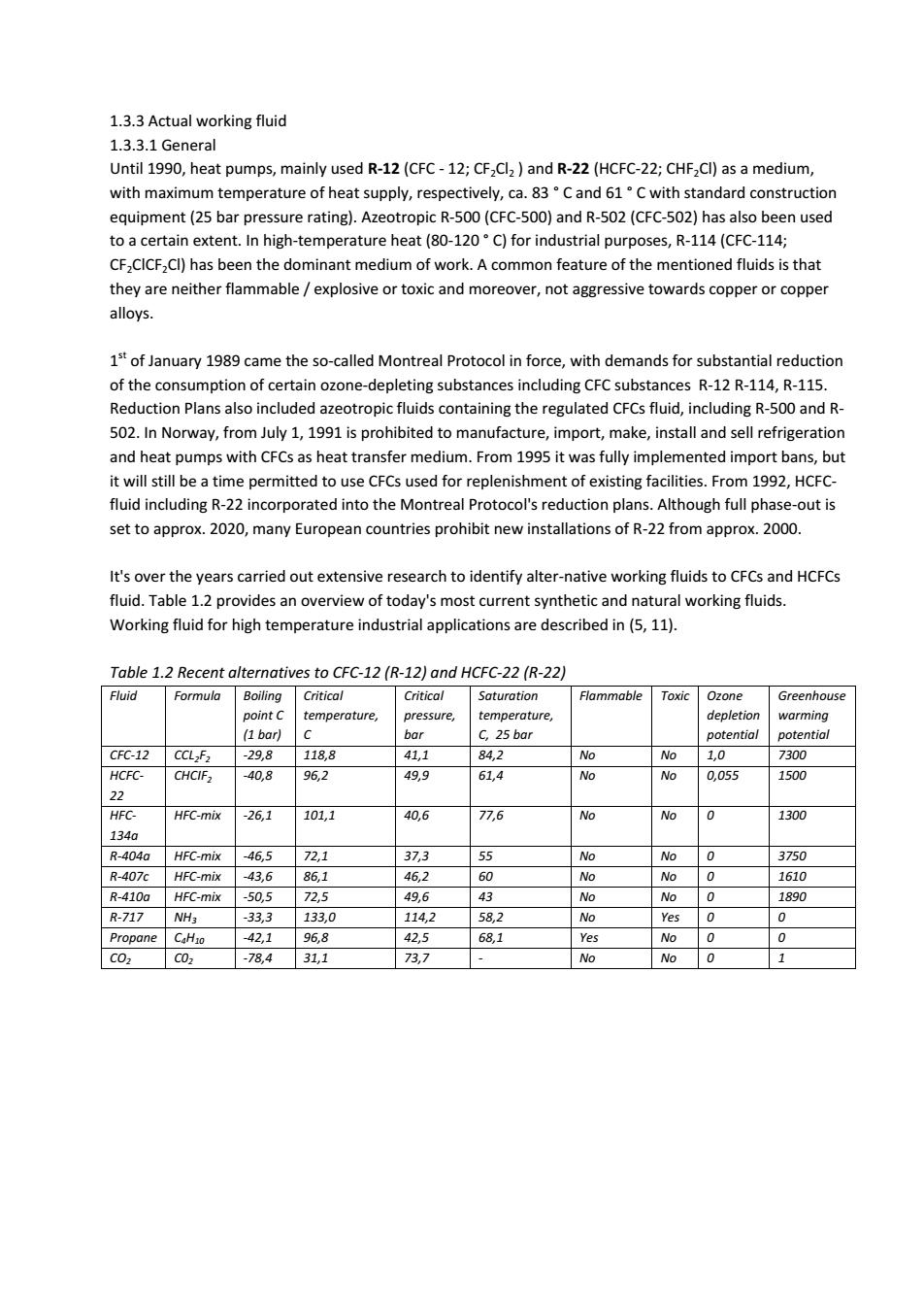正在加载图片...

1.3.3 Actual working fluid 1.3.3.1 General Until 1990,heat pumps,mainly used R-12(CFC-12;CF2Cl2)and R-22(HCFC-22;CHF2Cl)as a medium, with maximum temperature of heat supply,respectively,ca.83C and 61C with standard construction equipment(25 bar pressure rating).Azeotropic R-500(CFC-500)and R-502(CFC-502)has also been used to a certain extent.In high-temperature heat(80-120C)for industrial purposes,R-114(CFC-114; CF2CICF2Cl)has been the dominant medium of work.A common feature of the mentioned fluids is that they are neither flammable/explosive or toxic and moreover,not aggressive towards copper or copper alloys. 1st of January 1989 came the so-called Montreal Protocol in force,with demands for substantial reduction of the consumption of certain ozone-depleting substances including CFC substances R-12 R-114,R-115. Reduction Plans also included azeotropic fluids containing the regulated CFCs fluid,including R-500 and R- 502.In Norway,from July 1,1991 is prohibited to manufacture,import,make,install and sell refrigeration and heat pumps with CFCs as heat transfer medium.From 1995 it was fully implemented import bans,but it will still be a time permitted to use CFCs used for replenishment of existing facilities.From 1992,HCFC- fluid including R-22 incorporated into the Montreal Protocol's reduction plans.Although full phase-out is set to approx.2020,many European countries prohibit new installations of R-22 from approx.2000. It's over the years carried out extensive research to identify alter-native working fluids to CFCs and HCFCs fluid.Table 1.2 provides an overview of today's most current synthetic and natural working fluids. Working fluid for high temperature industrial applications are described in(5,11). Table 1.2 Recent alternatives to CFC-12(R-12)and HCFC-22(R-22) Fluid Formula Boiling Critical Critical Saturation Flammable Toxic Ozone Greenhouse point C temperature, pressure, temperature, depletion warming (1 bar) C bar C,25 bar potential potential CFC-12 CCL2F2 -298 118,8 41,1 84,2 No No 1,0 7300 HCFC- CHCIF2 -40,8 96,2 49,9 61,4 No No 0,055 1500 22 HFC- HFC-mix -26,1 101,1 40,6 77,6 No No 0 1300 134a R-404a HFC-mix -46,5 72,1 373 55 No No 0 3750 R-407c HFC-mix -43,6 86,1 46,2 60 No No 0 1610 R-410a HFC-mix -505 72,5 49,6 43 No No 0 1890 R-717 NH3 -33,3 133,0 114,2 58,2 No Yes 0 0 Propane CaHio -42,1 96,8 425 68,1 Yes No 0 0 C02 C02 -78,4 31,1 73,7 No No 0 11.3.3 Actual working fluid 1.3.3.1 General Until 1990, heat pumps, mainly used R-12 (CFC - 12; CF2Cl2 ) and R-22 (HCFC-22; CHF2Cl) as a medium, with maximum temperature of heat supply, respectively, ca. 83 ° C and 61 ° C with standard construction equipment (25 bar pressure rating). Azeotropic R-500 (CFC-500) and R-502 (CFC-502) has also been used to a certain extent. In high-temperature heat (80-120 ° C) for industrial purposes, R-114 (CFC-114; CF2ClCF2Cl) has been the dominant medium of work. A common feature of the mentioned fluids is that they are neither flammable / explosive or toxic and moreover, not aggressive towards copper or copper alloys. 1 st of January 1989 came the so-called Montreal Protocol in force, with demands for substantial reduction of the consumption of certain ozone-depleting substances including CFC substances R-12 R-114, R-115. Reduction Plans also included azeotropic fluids containing the regulated CFCs fluid, including R-500 and R- 502. In Norway, from July 1, 1991 is prohibited to manufacture, import, make, install and sell refrigeration and heat pumps with CFCs as heat transfer medium. From 1995 it was fully implemented import bans, but it will still be a time permitted to use CFCs used for replenishment of existing facilities. From 1992, HCFCfluid including R-22 incorporated into the Montreal Protocol's reduction plans. Although full phase-out is set to approx. 2020, many European countries prohibit new installations of R-22 from approx. 2000. It's over the years carried out extensive research to identify alter-native working fluids to CFCs and HCFCs fluid. Table 1.2 provides an overview of today's most current synthetic and natural working fluids. Working fluid for high temperature industrial applications are described in (5, 11). Table 1.2 Recent alternatives to CFC-12 (R-12) and HCFC-22 (R-22) Fluid Formula Boiling point C (1 bar) Critical temperature, C Critical pressure, bar Saturation temperature, C, 25 bar Flammable Toxic Ozone depletion potential Greenhouse warming potential CFC-12 CCL2F2 -29,8 118,8 41,1 84,2 No No 1,0 7300 HCFC- 22 CHCIF2 -40,8 96,2 49,9 61,4 No No 0,055 1500 HFC- 134a HFC-mix -26,1 101,1 40,6 77,6 No No 0 1300 R-404a HFC-mix -46,5 72,1 37,3 55 No No 0 3750 R-407c HFC-mix -43,6 86,1 46,2 60 No No 0 1610 R-410a HFC-mix -50,5 72,5 49,6 43 No No 0 1890 R-717 NH3 -33,3 133,0 114,2 58,2 No Yes 0 0 Propane C4H10 -42,1 96,8 42,5 68,1 Yes No 0 0 CO2 C02 -78,4 31,1 73,7 - No No 0 1